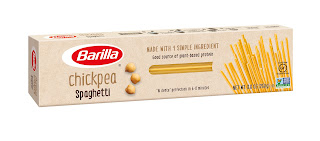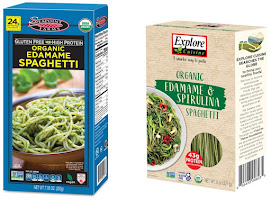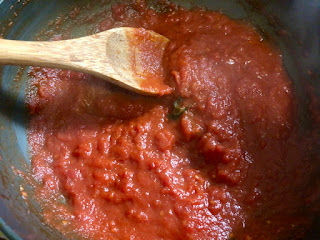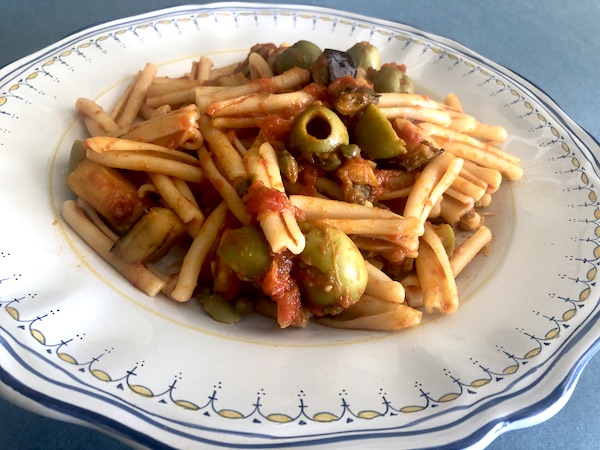15 Feb 2022
 Cooking with Amy: A Food Blog
Cooking with Amy: A Food Blog
How to Use Bean and Legume Pasta
Much as I love pasta, I'm not sure it loves me. Last year my carb-heavy comfort food diet led to some weight gain so I looked into low carb pasta as an alternative. There's a lot out there and I'm still trying different brands and styles, but I thought now would be a good time to share what I've learned so far.
 |
| Pasta with Butternut Squash and Brussels Sprouts |
My introduction to legume and bean-based pasta was thanks to Barilla. I was lucky because I got to attend a webinar with Barilla's incredible chef, Lorenzo Boni. I tried his recipe for pasta with butternut squash and Brussels sprouts which I definitely recommend and have now made several times. If you've seen his wildly popular (150k+ followers!) Instagram feed you know he's a master at making all kinds of pasta dishes and that he often eats plant-based meals. I followed up with him to get some tips on cooking with pasta made from beans and legumes.
Pasta made with beans and legumes is higher in protein and so the recommended 2-ounce portion is surprisingly filling. But the texture isn't always the same as traditional semolina or durum wheat pasta. Chef Boni told me, "The nature of legume pasta makes it soak up more moisture than traditional semolina pasta, so you always want to reserve a bit of cooking water to adjust if needed." But when it comes to cooking, he says that with Barilla legume pasta you cook it the same way as semolina pasta. "Boil in salted water for the duration noted on the box and you'll have perfectly al dente pasta." They are all gluten-free.
Chickpea pasta
When I asked Chef Boni about pairing chickpea pastas with sauce he said, "Generally speaking, I prefer olive oil based sauces rich with vegetables, aromatic herbs and spices. Seafood also pairs well with chickpea options. If used with creamy or tomato-based sauces, keep in mind to always have some pasta water handy to adjust the dish in case it gets too dry." He added, "One of my favorite ways to prepare a legume pasta dish would be a simple chickpea rotini with shrimp, diced zucchini and fresh basil. The sauce is light enough to highlight the flavor of the pasta itself, while the natural sweetness helps keep the overall flavor profile more appealing to everyone." I like the Barilla brand because the only ingredient is chickpeas. Banza makes a popular line of chickpea pasta as well although they include pea starch, tapioca and xanthan gum.
Edamame pasta
I tried two different brands of edamame pasta, Seapoint Farms and Explore Cuisine. The Seapoint pasta has a rougher texture than the Explore. With the Seapoint I found the best pairings were earthy chunky toppings like toasted walnuts and sautéed mushrooms. The Explore Cuisine edamame & spirulina pasta is smoother and more delicate, and worked well with an Asian style peanut sauce. I was happy with the Seapoint brand, but would definitely choose the Explore brand instead if it's available.
Red lentil pasta
Red lentil pasta is most similar to semolina pasta. Barilla makes red lentil pasta in a variety of shapes. But for spaghetti, Chef Boni says, "Barilla red lentil spaghetti is pretty flexible and works well with pretty much everything. I love red lentil spaghetti with light olive oil based sauces with aromatic herbs and some small diced vegetables. It also works well with a lean meat protein." I have to admit, I have yet to try red lentil pasta, but I'm excited to try it after hearing how similar it is to semolina pasta. It is made only with red lentil flour, that's it. It's available in spaghetti, penne and rotini.
Penne for Your Thoughts
Do you remember seeing photos from Italian supermarkets where the shelves with pasta were barren except for penne? I too seem to end up with boxes of penne or rotini and not a clue what to do with them so I asked Chef Boni his thoughts on the subject. He told me, "Shortcuts such as rotini and penne pair very well with all kind of ragouts as well as tomato based and chunky vegetarian sauces. One of my favorite ways to prepare a legume pasta dish would be a simple chickpea rotini with shrimp, diced zucchini and fresh basil. The sauce is light enough to highlight the flavor of the pasta itself, while the natural sweetness helps keep the overall flavor profile more appealing to everyone." Thanks chef! When zucchini is in season I know what I will try!
15 Feb 2022 6:46pm GMT
23 Nov 2021
 Cooking with Amy: A Food Blog
Cooking with Amy: A Food Blog
A Conversation with Julia Filmmakers, Julie Cohen and Betsy West
Julia is a new film based on Dearie: The Remarkable Life of Julia Child by Bob Spitz and inspired by My Life in France by Julia Child with Alex Prud'homme and The French Chef in America: Julia Child's Second Act by Alex Prud'homme. Julia Child died in 2004, and yet our appetite for all things Julia hasn't waned.
I grew up watching Julia Child on TV and learning to cook the French classics from her books, And while I never trained to be a chef, like Child I also transitioned into a career focused on food, a subject I have always found endlessly fascinating. I enjoyed the new film very much and while it didn't break much new ground, it did add a layer of perspective that can only come with time. In particular, how Julia Child became a ubiquitous pop culture figure is addressed in a fresh way.
I reached out to the filmmakers,Julie Cohen and Betsy West to find out more about what inspired them and why Julia Child still holds our attention.
Julia Child died over 15 years ago and has been off TV for decades. Why do you believe we continue to be so fascinated by her?
In some ways Julia is the Godmother of modern American cooking - and eating. Her spirit looms over cooking segments on the morning shows, The Food Network, and all those overhead Instagram shots the current generation loves to take of restaurant meals. Beyond that, though, Julia's bigger than life personality and unstoppable joie de vivre are infectious. People couldn't get enough of her while she was living, and they still can't now.
There have been so many Julia Child films and documentaries, what inspired this one?
Well there'd been some great programs about Julia but this is the first feature length theatrical doc. Like everyone else, we adored Julie & Julia, but a documentary gives you a special opportunity to tell a person's story in their own words and with the authentic images. This is particularly true of Julia, who was truly one of a kind.
The impact of Julia Child how she was a groundbreaker really comes across in the film, are we understanding her in a different light as time passes?
People understand that Julia was a talented television entertainer, but outside the professional food world, there's been an under-recognition of just how much she changed the 20th century food landscape. As Jose Andres points out in the film, almost every serious food professional has a sauce-splashed copy of "Mastering the Art of French Cooking" on their shelves. We also felt Julia's role in opening up new possibilities for women on television deserved more exploration. In the early 1960's the idea of a woman on TV who was neither a housewife nor a sex bomb but a mature, tall, confident expert was downright radical. She paved the way for many women who followed.
The food shots add an extra element to the film and entice viewers in a very visceral way, how did those interstitials come to be part of the film?
We knew from the start that we wanted to make food a major part of this story, not an afterthought. We worked with cook and food stylist Susan Spungen to determine which authentic Julia recipes could be integrated with which story beats to become part of the film's aesthetic and its plot. For instance the sole meunière is a key part of the story because it sparked her obsession with French food, and the pear and almond tart provides an enticing metaphor for the sensual side of Julia and Paul's early married years.
Note: Susan Spungen was also the food stylist for Julie & Julia
Julia is in theaters now.
23 Nov 2021 11:30pm GMT
05 Oct 2021
 Cooking with Amy: A Food Blog
Cooking with Amy: A Food Blog
Meet my Friend & Mentor: Rick Rodgers of the Online Cooking School Coffee & Cake
I met Rick Rodgers early in my career as a recipe developer and food writer when we were both contributors to the Epicurious blog. Not only is he a lot of fun to hang out with, but he has also been incredibly helpful to me and is usually the first person I call when I'm floundering with a project, client, or cooking quandary. His interpersonal skills, business experience, and cooking acumen explain why he's been recognized as one of the top cooking instructors in America. Literally.
You built a career as a cooking instructor and cookbook author. How many cookbooks have you written?
I was asked recently to make an official count, and It looks like an even hundred. Many of those were collaborations with chefs, restaurants, celebrities, bakeries, and business entities, such as Tommy Bahama, Williams-Sonoma, and Nordstrom. I made it known that I was available for collaboration work, and my phone literally rang off the hook for quite a few years with editors and agents looking for help with novice writers or those that wanted a branded book.
Which cookbook(s) are you most proud of?
There are three books that I get fan mail for almost every day: Kaffeehaus (where I explore the desserts of my Austrian heritage), Thanksgiving 101 (a deep dive into America's most food-centric holiday and how to pull it off), and Ready and Waiting (which was one of the first books to take a "gourmet" approach to the slow cooker). These books have been in print for 20 years or more, which is a beautiful testament to their usefulness to home cooks.
How did you get started as a cooking instructor and what are some highlights of your teaching career?
I was a theater major at San Francisco State College (now University), so getting in front of a crowd held no terrors for me. When more brick-and-mortar cooking schools opened in the eighties, I was ready for prime time. During that period, there were at least twelve cooking schools in the Bay Area, so I made quarterly trips here a year from the east coast, where I had moved. My Thanksgiving classes were so popular that I taught every day from November 1 to Thanksgiving, with a couple of days off for laundry and travel. The absolute pinnacle of my teaching career was being named Outstanding Culinary Instructor of The Year by Bon Appétit Magazine's Food and Entertaining Awards, an honor that I share with only a handful of other recipients, including Rick Bayless and Bobby Flay.
 |
| Flódni |
How have cooking classes changed since you started?
Because there are so many classes available, I can teach at any level of experience. At the cooking schools, we tended to walk a fine line between too difficult and too easy. The exposure to different cuisines and skill levels on TV also has seriously raised the bar. Unfortunately, students want to walk before they can run. They want to learn how to make croissants when I doubt that they can bake a pound cake correctly. It is best to build on your skills instead of going right to the top. That being said, in my online classes, I am concentrating on the more challenging recipes because that is what the market demands of me.
Tell me about your baking school, coffeeandcake.org
As much as I loved my cookbooks and in-person classes, I knew there was a more modern way to reach people who wanted to cook with me, especially since so many cooking schools had closed. I retired the day I got my first Social Security check. But…as I was warned by my friends who knew me better than I did…I was bored, and wanted a new project. I heard about online classes through other teachers who were having success. I found an online course specifically for cooking classes (Cooking Class Business School at HiddenRhythm.com), got the nuts and bolts down, and I finally entered the 21st century!
How do you decide which recipes to teach?
I felt there were plenty of other places to learn how to make chocolate chip cookies and banana bread-just take a look on YouTube alone. I had a specialty of Austro-Hungarian baking thanks to my Kaffeehaus book, so I decided to niche into that category. I have branched out to a few other locations, but my goal is to expose students to something new and out of the ordinary. I also survey my students on what they would like me to teach, and those answers are amazing. People are truly interested in the more difficult desserts. Perhaps it is because so many people discovered baking as a hobby during the pandemic?
For students who have your cookbooks, what are the advantages of taking an online class?
There is no substitute for seeing a cook in action. Plus you get to answer questions during class. In a recent class, I made six-layer Dobos Torte in two hours' real-time to prove that you can do it without giving up a week of your life. And we don't have to travel to each other to be "together." My classes are videotaped so you can watch them at your convenience.
What are some highlights of your upcoming schedule of classes?
 |
| Honey cake |
In October, I am teaching virtually all Hungarian desserts, things that will be new to most people. I am making one of my absolute favorites, Flódni, which is a Jewish bar cookie (almost a cake) with layers of apple, poppy seeds, and walnuts between thin sheets of wine-flavored cookie dough. San Franciscans in particular will be happy to see a master class that I am teaching with the delightful Michelle Polzine, owner of the late and lamented 20th Century Cafe and author of Baking at the 20th Century Cafe. We will be making her (in)famous 12-layer honey cake on two coasts, with me doing the heavy lifting in New Jersey and Michelle guiding me from the west coast. That is going to be fun! In November and December, I am switching over to holiday baking and a few savory recipes for Thanksgiving, including my fail-proof turkey and gravy, which I have made over 300 times in classes over 30 years' worth of teaching. It ought to be perfect by now
Head to Coffee and Cake to sign up for classes or learn more.
05 Oct 2021 3:56pm GMT
16 Aug 2021
 Cooking with Amy: A Food Blog
Cooking with Amy: A Food Blog
All about Saffron and Saffron Scented Fennel & Chickpea Stew Recipe
Like so many people, when I've traveled to Spain, I've come back with packages of saffron. But recently I met Negar Ajayebi, whose company Baron Saffron is importing the most exquisite organic Persian saffron. The color is incredibly vibrant and the aroma intense and complex. Frankly, it was way better than anything I ever had before. I spoke with Ajayebi to learn more about this exquisite spice and how to use it.
How did you get into the saffron business?
What is something that most Americans don't know about saffron?
Most Americans use the threads to add taste, but the point is that you should grind the threads and brew them! It has so many health benefits as well. The use of saffron as a medicinal plant dates back to ancient times, with its reported therapeutic applications ranging from complaints of the eye, skin, respiratory, digestive, and genitourinary tracts, to mood disorders and as a general tonic.
What makes Persian saffron so special compared to saffron from other countries?
Saffron, like other flowers, needs a unique climate to grow up well. The geographical parameters in the great Khorasan (the eastern part of Iran and western part of Afghanistan), aka soil, water, and temperature, make it the best place to grow up saffron. This flower needs too much attention, which means a lot of labor costs. So economical parameter is another issue.
Can you explain the lab testing of saffron and grading?
The standard test for saffron is ISO 3632-2, which clarifies the three characteristics' saffron sample:
• Safranal: This index represents the smell of saffron. The high-quality saffron scores over 40
• Crocin: This shows the color of saffron. Pure and fresh saffron gets over a score of 250
• Picocrocin: This demonstrates the flavor of saffron. If the test has over 80, you can trust it
I think a lot of people like me buy it and use it infrequently. How important is it for saffron to be fresh?
The fresher, the better! Keeping saffron in a dry and nearly cold place is a must. It should be kept dry and in a closed lid container.
How do you use saffron, and how much is typically needed per recipe?
The best way to use saffron is to brew it. Brewing the saffron releases the most aroma and color, and taste. To have a better result, we usually grind the saffron's threads. It practically helps to release its flavor and aroma three times more! The amount of saffron used in the recipes depends on how much you want the taste to be strong and how much you believe in saffron!
You recommend grinding the saffron and brewing it with ice at room temperature. Why is that?
It's a traditional way we learned from our ancestors, and that's because we believe precisely like coffee, cold brewing draws the most aroma and color and tastes out of saffron.
SPECIAL OFFER: If you'd like to purchase saffron, Baron Saffron is offering free shipping with the code cookingwithamy. I hope you'll try this truly exquisite saffron and let me know how you use it in the comments. I can personally attest a very little bit goes a long way. Thanks Negar!
Saffron Scented Chickpea and Fennel Stew
Serves 4
Ingredients
2 heads of fennel, chopped, (save the core)
1 teaspoon extra virgin olive oil
1 large onion, chopped (save the peel and scraps)
1 yellow pepper or 5 mini peppers, seeded and chopped
2 cloves garlic, minced
1 can or 1 1/2 cups of cooked chickpeas
1/2 cup orange juice
1 cup of fennel onion broth
1 can of cherry tomatoes (15 ounces)
Pinch of saffron
Instructions
In a small saucepan combine the reserved fennel core and onion scraps. Cover with water and simmer to make a broth. Meanwhile, heat a soup pot and add the oil. Gently fry the onion, fennel, and peppers until soft and beginning to turn golden brown, about 10 minutes. Add the garlic and stir until fragrant.
Add the chickpeas, orange juice, about a cup of the fennel onion broth, the cherry tomatoes and their liquid, and a pinch of saffron. Simmer for 10-15 minutes or until thick and fragrant. Season to taste with salt. Serve with bulgar or rice.
Enjoy!
16 Aug 2021 12:09am GMT
14 Jun 2021
 Cooking with Amy: A Food Blog
Cooking with Amy: A Food Blog
News & Ways to Stay in Touch
14 Jun 2021 6:23pm GMT
18 May 2021
 Cooking with Amy: A Food Blog
Cooking with Amy: A Food Blog
Gnocchi alla Sorrentina Recipe & Contest
Just as Margherita pizza is symbolic of Naples, gnocchi alla Sorrentina is emblematic of Sorrento. Like the Margherita, it features the colors of the Italian flag thanks to tomato, mozzarella and basil.That trinity seems like the most classic of Italian ingredients, but is it? Basil is not native to the Mediterranean, it came to Italy from India via the spice routes. Tomatoes came from the New World and didn't make their way to Italy until the 15th or 16th century, the same for potatoes, which are a key ingredient in gnocchi in many regions. I've read that potatoes were used because at one time the price of wheat was very high but I don't know if that's actually true or not.
18 May 2021 10:04pm GMT
14 Mar 2021
 Cooking with Amy: A Food Blog
Cooking with Amy: A Food Blog
The Truffle Hunters
I got to meet people in the truffle business a few years ago when I was the blogger for the Napa Truffle Festival. I even blogged about truffle dogs. I am not a big fan of dogs but fell head over heels in love with the adorable Lagotto Romangnolos. Affectionate, smart and energetic, they were irresistible. The award winning documentary The Truffle Hunters features not just truffle dogs, but the dog's owners, and some truffle brokers.
This delightful and quiet documentary transports you to Piemonte in Italy and takes you into the hidden world of the truffle hunters, both the men and their dogs. But it also shares the dark side of the business. The truffle business is notoriously shady. In some sections of the film you literally get a dog's eye view of truffle hunting. But the real charm are the men themselves and their relationships with friends, clients and their undying love for their dogs. Like the film itself, they are quirky, eccentric, funny and intense.
Truffles are all about scent, and this film not only conjures up the smell of precious white truffles, but is a banquet for all the senses-the sounds of nature, the damp chill of the forest, and the beauty of lives led in a way that is perhaps as precious and rare as truffles themselves. The film is now playing in select cities. Check Truffle Hunters website for more information.
14 Mar 2021 11:04pm GMT
06 Nov 2020
 Cooking with Amy: A Food Blog
Cooking with Amy: A Food Blog
The Best 3-Ingredient Cookbook Review & Roasted Grapes and Yogurt Recipe
06 Nov 2020 9:27pm GMT
30 Oct 2020
 Cooking with Amy: A Food Blog
Cooking with Amy: A Food Blog
Pasta with Eggplant, Olives and Capers Recipe
 |
| Left: conventional tomato and Right: San Marzano DOP tomato |
The DOP designation means they meet Protected Designation of Origin certification, with strict geographical and production standards. They are a specific type of tomato with a distinctive bittersweet flavor and low acidity, they have few seeds and a long shape, and meaty texture because they have only two seed pockets. They are grown in the volcanic soil of the Sarno Valley that is high in potassium and phosphorus. San Marzano tomatoes are harvested 7-8 times or more only by hand from July to September, to ensure they are perfectly ripe and only after sunset. After harvest, the tomatoes are peeled, placed in cans, and are processed for 13 minutes.
Canned tomatoes imported from Europe are more expensive than other canned tomatoes you may find, but you are getting a product that is consistently high quality and will ensure a great sauce for your pasta, especially if you're making a Southern Italian style recipe, like mine for pasta with eggplant, olives, and capers. Head to @cookingwithamy for details on how to win a gift pack of European products, including the tomatoes Pomodoro San Marzano dell'Agro Sarnese-Nocerino, olive oil, balsamic vinegar, pasta, etc. Additionally, the winner gets to choose a family, frontline worker, charity, hospital, or person to also receive a gift pack!
Pasta with Eggplant, Olives, and Capers
8 servings
Ingredients
1 pound casarecce or similar pasta
2 garlic cloves, smashed
2 Tablespoons extra virgin olive oil
1 cup green or black olives, pitted and sliced
1/4 cup capers
1 medium eggplant (or 1/2 large eggplant) about 12 ounces or 4 cups, diced
1 28 oz can Pomodoro San Marzano dell'Agro Sarnese-Nocerino
Pecorino, grated
Instructions
Heat the oven to 400 degrees. Place the eggplant on a rimmed baking sheet and drizzle or spray with olive oil and roast for 15-20 minutes or until cooked through but still holding its shape.
Meanwhile, cook pasta according to directions and drain. Add the olive oil to a large skillet, sauté the garlic for one minute, add olives and capers and cook for another minute or until fragrant. Add tomatoes, mashing them with a wooden spoon, and simmer for 10 minutes or until thick and saucy. Add the eggplant and stir until well coated.
Toss the drained pasta with the sauce, serve with cheese.
Enjoy!
30 Oct 2020 8:29pm GMT
19 Aug 2020
 Cooking with Amy: A Food Blog
Cooking with Amy: A Food Blog
Lay's Supports Iconic Restaurants & You Should Too
I don't have to tell you that restaurants are suffering. In the beginning of the pandemic many launched GoFundMe style campaigns to try and stay afloat. Restaurants also keep pivoting from offering pantry staples to meal kits, cooking classes, take out, delivery and more to make up for the loss of their normal business.
Independent restaurants numbered 500,000 before the pandemic and employed over 11 million people according to the Independent Restaurant Coalition and some industry analysts believe 2/3 of restaurants will not survive the crisis in the US. Yelp data shows 26,160 restaurants have closed as of the end of July. Restaurants are pushing for a $120B Independent Restaurant Revitalization Fund. You can ask your representatives to support this initiative.
Since 2104 Lay's has offered limited edition "flavor icon" potato chips that honor classic dishes. In past years there's been Everything Bagel and Cream Cheese, Fried Green Tomato, and even Crispy Taco. This year they honor four restaurants and dishes, and in light of the pandemic, they are giving a $25,000 Gratitude Fund to each of the Flavor Icons restaurants to put towards the various relief efforts that will help them recover from the impact of the pandemic. The potato chips contain no artificial flavors.
I got a chance to try four flavors:
Wavy Carnitas Street Taco flavored inspired by El Torito
Notes of bacon, onion and corn, which is interesting in a potato chip. Good for dipping.
My favorite of all the flavors.
Kettle Cooked New York Style Pizza flavored inspired by Grimaldi's
I get a combination of tomato sauce and cheese.
They would go great with a grilled cheese sandwich.

Philly Cheesesteak flavored inspired by Geno's Steaks
Very beefy, umami notes not as much cheese flavor as I expected.
I would actually like to try these with or in a roast beef sandwich.

Nashville Hot Chicken flavored inspired by Partry Fowl
Spicy! Not very chicken-y though.
These will be popular with barbecue potato chip lovers.
So what's iconic where you live? If you can, support the restaurants you love, for many of them, it's now or never.
Disclaimer: My thanks to Lay's for providing samples for me to try.
19 Aug 2020 10:28pm GMT
28 May 2020
 Cooking with Amy: A Food Blog
Cooking with Amy: A Food Blog
Pandemic Provisions
I've also been buying dumplings, ramen, baked goods and taking cook-along classes at home, I'll share the details on those soon along with a list of where to find great takeout and delivery options.
28 May 2020 3:08pm GMT
12 May 2020
 Cooking with Amy: A Food Blog
Cooking with Amy: A Food Blog
Dijon Mustard Black Cod with Cabbage & Potatoes
12 May 2020 4:22pm GMT
22 Apr 2020
 Cooking with Amy: A Food Blog
Cooking with Amy: A Food Blog
Caesar Salad Recipe
Note: This dressing in this recipe makes enough for 4 main courses or 6-8 as a side salad. The salad dressing will keep for a few days in the refrigerator.
22 Apr 2020 5:18pm GMT
21 Apr 2020
 Cooking with Amy: A Food Blog
Cooking with Amy: A Food Blog
Ginger Matcha Walnuts Recipe
21 Apr 2020 11:12pm GMT
17 Apr 2020
 Cooking with Amy: A Food Blog
Cooking with Amy: A Food Blog
Lavender London Fog Latte Recipe
17 Apr 2020 1:54am GMT
03 Apr 2020
 Cooking with Amy: A Food Blog
Cooking with Amy: A Food Blog
Angkor Cambodian Sauces
03 Apr 2020 8:57pm GMT


























